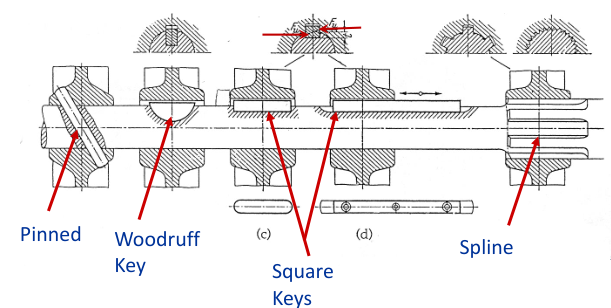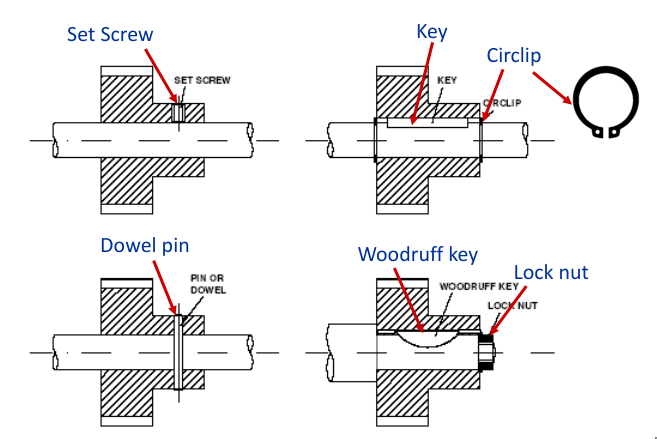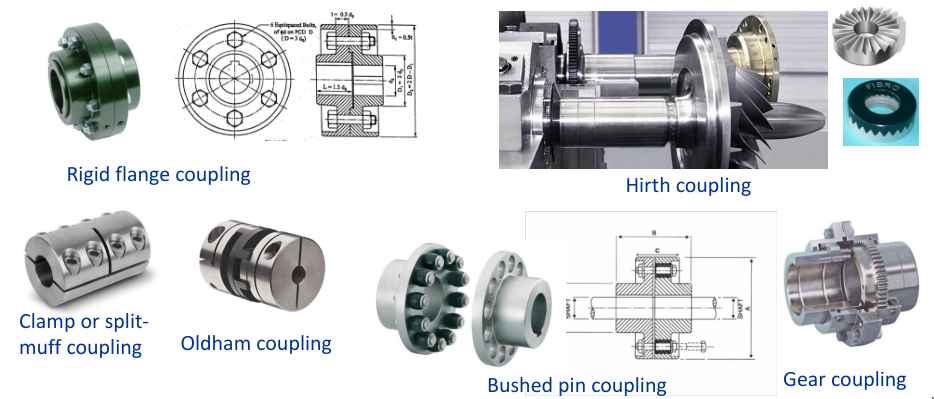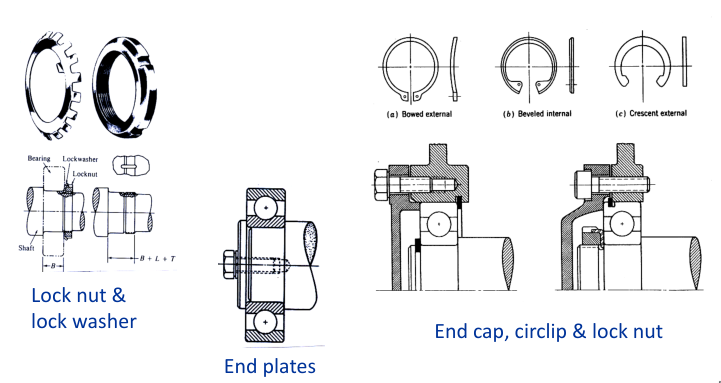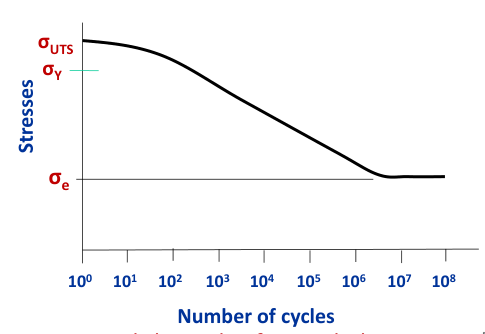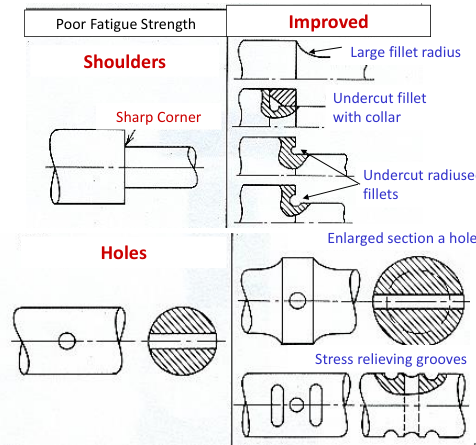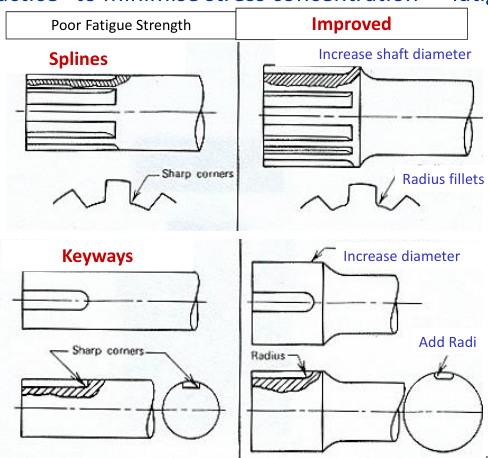6.1 KiB
Executable File
| author | date | title | tags | uuid | |||
|---|---|---|---|---|---|---|---|
| Akbar Rahman | \today | MMME2044 // Shaft Design |
|
8e0928a6-c20c-4f80-9691-beb2defa4022 |
Shaft Design Considerations
- Function and loading
- Size and connection to components
- Material selection and treatments
- Deflection and rigidity
- Stress and strength
- Critical speed
- Manufacturing constraints
Shaft-Hub Connections
Shaft-Shaft Connections
Shaft-shaft connections can use either rigid or flexible couplings.
Location of Bearing on Shaft
Shaft Loading
-
Axial stresses
- cause by self-weight in vertical shafts
- due to axial restraint at bearings and associated axial load
-
bending stress
- due to bending moment in belt drivers, gear forces, mounted component weights
- dynamic forces which can load to fatigue and resonance
-
shear stresses
- due to torque load/direct shear
Shaft Diameter (ASME Design Code)
d = \left[
\frac{32n_s}{\pi}
\sqrt{
\left(\frac{M}{\sigma_e}\right)^2
+ \frac34 \left(\frac{T}{\sigma_y}\right)^2
}
\right]^{\frac13}
where:
n_sis safety factorMis max bending moment (Nm)Tis max torque (Nm)\sigma_eis endurance limit stress (Pa)\sigma_yis yield strength of shaft (Pa)
ASME Design Code Derivation
-
Bending moment creates alternating tensile/compressive stresses (
\sigma_a):\begin{align} \sigma &= \frac{My}{I} \ I &= \frac{\pi d^4}{64} \end{align}
Combine to get:
\sigma_a = \frac{32M}{\pi d^3} -
Torque normally generates constant shear stress (
\tau_m):\begin{align} \tau &= \frac{TR}{J} \ J &= \frac{\pi d^4}{32} \end{align}
Combine to get:
\rightarrow \tau_m = \frac{16T}{\pi d^3} -
von Mises stress in plane stress condition:
\sigma_\text{von Mises} = (\sigma^2 + 3\tau^2)^{\frac12} -
ASME Fatigue Failure Criterion
\left(\frac{n_s\sigma_a}{\sigma_e}\right)^2 + \left(\frac{n_s\sigma_m}{\sigma_Y}\right)^2 = 1Finally substitute
\sigma_aand\tau_mto makedthe subject.
Endurance Limit Stress, \sigma_e
\sigma_e is the level of stress with which fatigue failure wouldn't occur in cycling or
alternating load conditions:
\sigmaat failure decreases with the number of cycles up until a certain point (\sigma_eafter around10^6cycles)- if you never exceed this point then the material will last for "infinite" cycles
- most steels have this fatigue behaviour so they are often used for shafts
Time for a silly equation:
\sigma_e = k_ak_bk_ck_dk_ek_fk_g\sigma_e'where:
k_a--- surface factork_b--- size factork_c--- reliability factork_d--- temperature factork_e--- duty cycle factork_f--- fatigue stress concentration factork_g--- miscellaneous effects factor\sigma_e'--- endurance limit of test specimen
this is a joke of an equation
Reducing Stress Concentrations
Critical Speed of Shaft (Natural Frequency)
-
operational speed of shat should be half the critical speed
-
Centre of Mass should be on the Centre of Rotation
-
in practice this is not the case
-
this imbalance causes a deflection (due to centrifugal force,
mr\omega^2 -
the critical speed (or natural frequency) is the speed at which the shaft is unstable
when this is the case it may cause damage to the shaft, bearings, and other destructive vibrations
Critical Speed Equation
\omega_c = \sqrt\frac{g}{\delta_\text{st}}where g is acceleration due to gravity and \delta_\text{st} is
static deflection of the shaft.
Rayleigh Ritz Equation
When you have multiple masses the Rayleigh-Ritz equation may be more suitable:
\omega_c = \sqrt{g\frac{\Sigma w_i\delta_i}{\Sigma w_i\delta_i^2}} where w_i is the weight of node i and \delta_i is the static deflection at node i.
Shaft Deflection
-
Shaft deflection is required to determine the critical speed.
-
Macaulay's method for the deflection in beam bending:
\frac{\mathrm{d}^2y}{\mathrm{d}x^2} = \frac{M}{EI}y = \int^x_0\int^x_0\left(\frac{M}{EI}\right) \mathrm{d}x + C_1x + C_2
Shaft Deflection Equations
-
Maximum deflection:
\delta_\text{max} = \frac{PL^3}{3EI} -
Deflection at any point
x\delta = \frac{Px^3}{6EI}(3L-x)
-
Maximum deflection:
\delta_\text{max} = \frac{PL^3}{48EI} -
Deflection at any point:
\delta = \frac{Px}{12EI} \left(\frac{3L^2}{4} - x^2 \right)
-
Maximum deflection
\delta_\text{max} = \frac{Pb^2L}{3EI} -
Deflection at any point
-
For
0 \le x \le a:\delta = \frac{Pbx}{6aEI}(x^2-a^2) -
For
0 \le z \le b:\delta = \frac{Pbx}{6aEI}\left(z^3 - b(2L+b) + 2b^2L\right)
-
Safety Factor
Safety Factor (also known as reserve factor) is a simple way to accommodate for uncertainties in design.
Simply multiply the maximum stresses and loads you expect by the safety factor, n_s, and assume
that as your maximum stress and load.
n_s |
Operational conditions and use of materials |
|---|---|
| 1.25-1.50 | Reliable materials under controlled conditions, known stresses with certainty |
| 1.50-2.00 | Well-known materials under reasonably constant environmental condition, known stresses |
| 2.00-2.50 | Average materials subjected to known loads and stresses and environment (LSE) |
| 2.50-3.00 | Lesser well-known materials under average conditions LSE |
| 3.00-3.40 | Untried materials under average conditions of stresses and environment, or well known materials under uncertain LSE |
